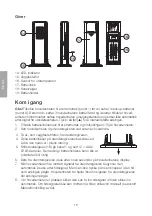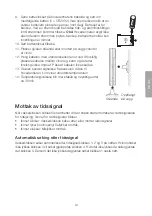
6
English
Freestanding
Mounted
on a wall
8. The time will be set automatically if the main unit is able to receive the radio time
signal. If a signal cannot be received then the time must be set manually (refer to
the
Manual time setting
section).
Time signal reception
As soon as it is plugged into the power supply, the alarm clock begins to receive radio
signals for setting the clock. The radio signal icon (5) will flash.
• When the icon flashes, the alarm clock is searching for or processing a signal.
• When the icon shines steadily, the signal reception has been successful.
• When the icon disappears, the reception has failed.
Automatic time signal search
The alarm clock searches for a signal every day at 1 am, 2 am and 3 am. If the alarm
clock fails to receive a signal at 3 am, it tries again at 4 am. If the alarm clock fails to
receive a signal at 4 am, it tries again at 5 am. If the alarm clock fails to receive a signal
at 5 am, it tries again at 1 am the next day.
11. Stand the sensor up or mount it on
a wall next to a window.
12. Hang the outdoor sensor’s cable out
of a window, between the window
frame and window and close
the window gently. Make sure that
the cable is not damaged during
closing.
13. The outdoor sensor will transmit to
the main unit, which will then display
the outdoor temperature.
14. The temperature readings will
become more stable and accurate
after about 30 minutes.
9. Remove the battery cover on the back of the main unit and insert
the included 1 × CR2032 battery. Make sure that the positive
terminal of the battery is facing upwards. The battery is just
a back-up. If there is a power cut, the back-up battery will save
the time and alarm settings until the power comes back on.
Note:
The main unit’s alarm will not sound if there is a power cut,
the back-up battery only saves the settings.
10. Refit the battery cover.
Summary of Contents for 36-5333
Page 2: ...2 ...







































